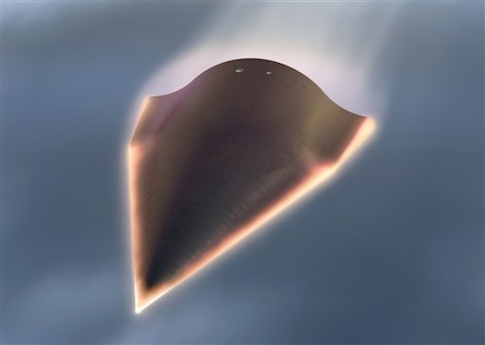China’s defense ministry on Friday confirmed a fourth test of a new hypersonic strike vehicle was carried out last week.
"The scheduled scientific research and experiments in our territory [are] normal, and those tests are not targeted at any country and specific goals," said the ministry in response to a report of the test published Thursday by the Washington Free Beacon.
U.S. defense officials disclosed the latest test of what the Pentagon calls the Wu-14 hypersonic glide vehicle and said the most recent test, conducted June 7 in western China, involved extreme maneuvers by the high-speed strike weapon.
The advanced strategic strike weapon travels at speed of up to 10 times the speed of sound, or more than 7,600 miles per hour.
The Wu-14 test was carried out amid heightened tensions between the United States and China over Chinese aggression in the South China Sea.
The test also took place days before a top Chinese military leader, Gen. Fan Changlong, vice chairman of the Central Military Commission, met senior U.S. officials in Washington.
Defense Secretary Ash Cater met Fan at the Pentagon on Friday and discussed China’s island building in the South China Sea.
"Carter reiterated U.S. concerns on the South China Sea, and called on China and all claimants to implement a lasting halt on land reclamation, cease further militarization, and pursue a peaceful resolution of territorial disputes in accordance with international law," the Pentagon said in a statement on the meeting.
Critics in Congress said Fan should not be allowed to visit the United States in light of recent reports of the Chinese military’s hacking of U.S. government computer networks, and the aggression in the South China Sea.
Chinese analysts said the Wu-14 test, launched atop a ballistic missile, was timed to the Fan visit as a way to express China’s displeasure with U.S. opposition to Chinese island-building in disputed waters of the South China Sea, the South China Morning Post reported.
"The test is aimed at helping Fan increase the People's Liberation Army's bargaining power on the negotiation table when he deals with his U.S. counterpart," Macau-based military analyst Antony Wong Dong told the Hong Kong daily.
Another Chinese analyst, He Qisong of Shanghai University, said the hypersonic glide vehicle test was a political message in response to the flight of a U.S. P-8 surveillance aircraft two week ago over the South China Sea.
"The Wu-14 … is designed to penetrate US missile defense systems, meaning the PLA is capable of defending China's territorial sovereignty," he said. "But such a test is only a nuclear deterrence. Neither China nor the U.S. wants to declare war over the South China Sea issues."
The June 7 Wu-14 test was the fourth time China tested the ultra-high-speed maneuvering weapon. Earlier tests took place in 2014 on Jan. 9, Aug. 7, and Dec. 2.
The Washington Free Beacon first reported the tests.
U.S. intelligence has assessed the Wu-14 to be a nuclear delivery vehicle designed to defeat U.S. missile defenses, which currently are designed to counter ballistic missiles and warheads that have predictable trajectories.
Current U.S. missile defenses are not capable of countering maneuvering targets, such as the Wu-14. The U.S. government insists that its missile defenses are not designed to counter Chinese or Russian strategic missiles.
The Wu-14 can travel up to 10 times the speed of sound, or around 7,680 miles per hour.
A congressional China commission stated in a report published last fall that "hypersonic glide vehicles could render existing U.S. missile defense systems less effective and potentially obsolete."
China also is developing a hypersonic weapon that employs a high-technology scramjet engine.
The Pentagon has said its main counter to such maneuvering high-speed missiles is an extended-range version of the Army’s Terminal High Altitude Area Defense, or THAAD, missile defense system.
The House version of fiscal 2016 defense authorization bill would add $291 million for the advanced THAAD development to counter hypersonic threats.
